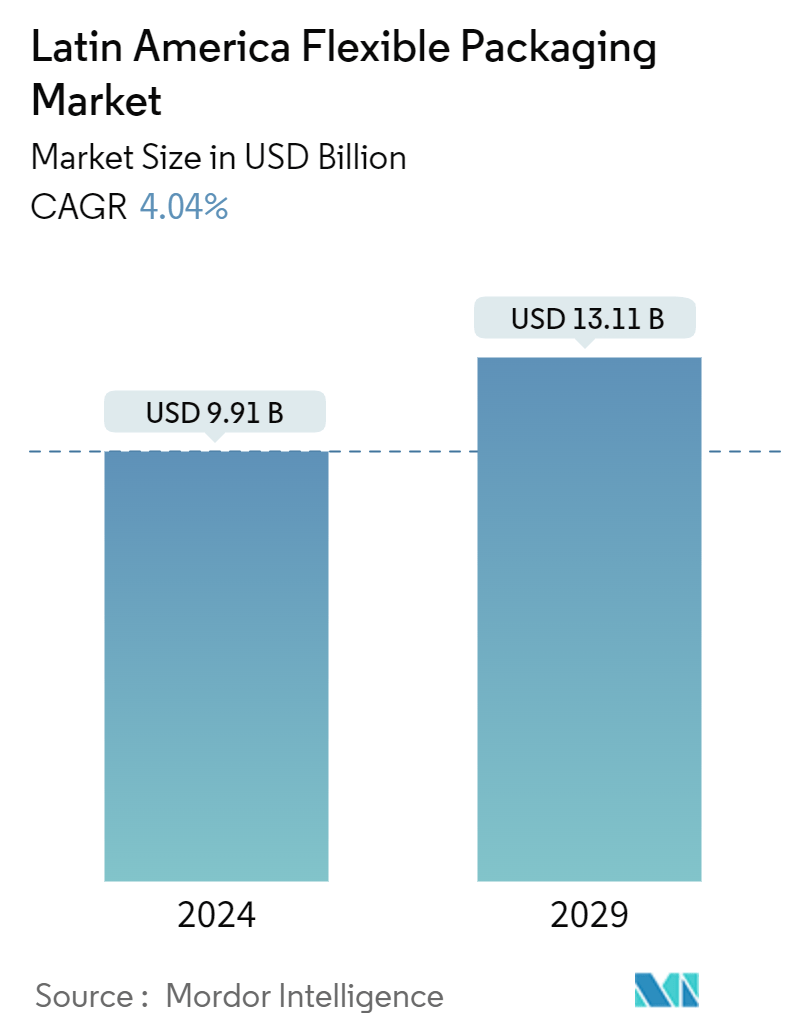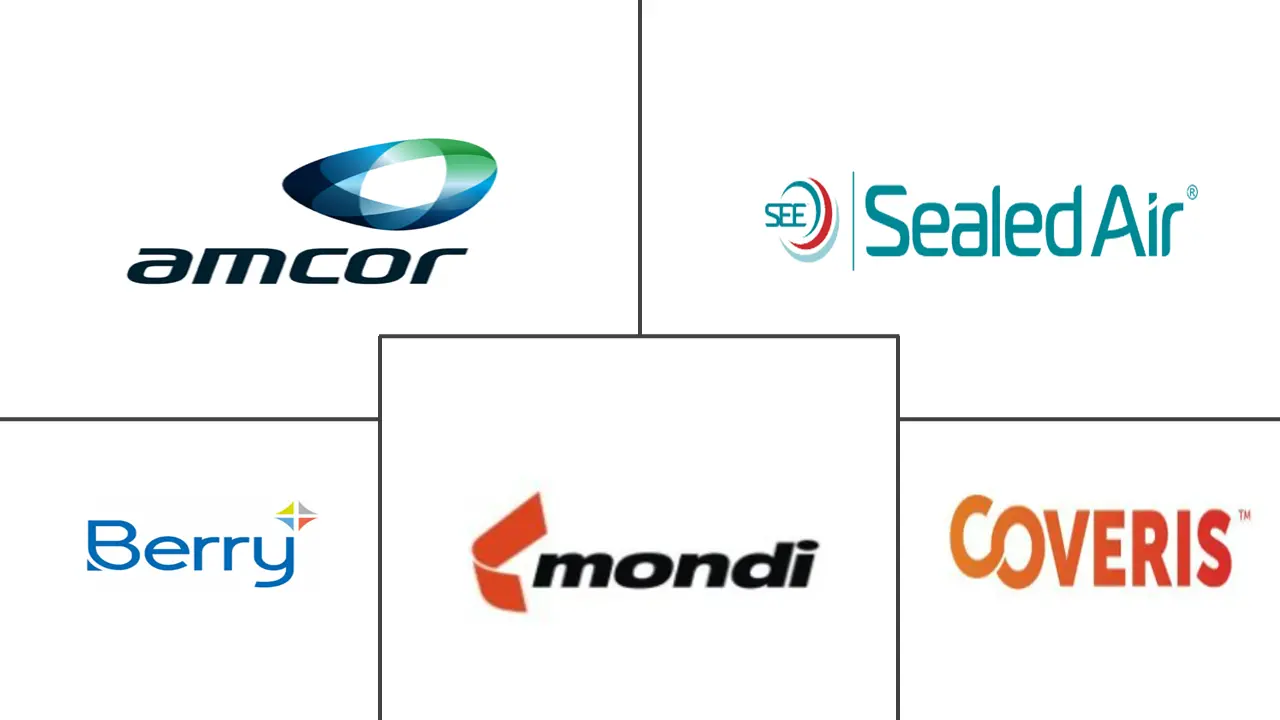Market Size of Latin America Flexible Packaging Industry

| Study Period | 2019 - 2029 |
| Base Year For Estimation | 2023 |
| Market Size (2024) | USD 9.91 Billion |
| Market Size (2029) | USD 13.11 Billion |
| CAGR (2024 - 2029) | 4.04 % |
| Market Concentration | Medium |
Major Players
*Disclaimer: Major Players sorted in no particular order |
Latin America Flexible Packaging Market Analysis
The Latin America Flexible Packaging Market size is estimated at USD 9.91 billion in 2024, and is expected to reach USD 13.11 billion by 2029, growing at a CAGR of 4.04% during the forecast period (2024-2029).
- Manufacturers benefit from substantial cost savings as flexible packaging consumes less raw materials and energy during production. Its efficient wrapping capabilities and reduced storage space requirements further boost its demand in the market.
- Trends like innovative packaging and digital printing are energizing the market, showcasing technological advancements. These include creative consumer engagement solutions, such as serialized QR codes. Additionally, the lightweight nature of flexible packaging cuts down transportation costs and fuel usage, making it a favored choice for snacks and potato chip packaging in the studied regions.
- In response to rising demand, several market players are forging collaborations and partnerships to enhance their revenues. For example, in May 2024, SGK's team in Brazil partnered with Johnson & Johnson Brazil to launch SEMPRE LIVRE. Their sustainability efforts earned them the Popular Vote category at the 20th ABRE Brazilian Packaging Award. SGK and Johnson & Johnson broke new ground with their first flexible film packaging. They crafted a thinner insert for female care products, using 33% post-consumer resin, and achieved a commendable 10.25% carbon footprint reduction over traditional packaging.
- The Argentine packaging sector grappled with challenges during the economic downturn, worsened by the pandemic. A significant drop in purchasing power among low and middle-income groups stifled innovation and premium packaging ventures. With wages plummeting, unemployment rising, and consumption habits shifting, the effects were felt across various packaging types and sizes.
- In the past decade, there has been a marked surge in public awareness about the detrimental effects of plastic. Latin American governments have spearheaded numerous public campaigns and initiatives, amplifying this awareness. Consequently, the consumption of plastic packaging has seen a pronounced shift in recent years.
Latin America Flexible Packaging Industry Segmentation
Flexible packaging is lightweight bags or pouches sealed using heat or pressure. In most cases, flexible packaging is designed to help extend the shelf-life of food products or to fulfill other marketing trends, such as high-quality graphics.
The Latin American flexible packaging market is segmented by material type (plastics, paper, and aluminum foil), product type (pouches, bags, films, and wraps), end-user industry (food, beverage, pharmaceutical and medical, household and personal care, and other end-user industries), and country (Brazil, Argentina, Mexico, and Rest of Latin America). The market sizes and forecasts are provided in terms of value (USD) for all the above segments.
| Material Type | |||||||
| |||||||
| Paper | |||||||
| Aluminum Foil |
| Product Type | |
| Pouches | |
| Bags | |
| Films and Wraps | |
| Other Product Types |
| End-user Industry | |||||||||
| |||||||||
| Beverage | |||||||||
| Pharmaceutical and Medical | |||||||||
| Household and Personal Care | |||||||||
| Other End-user Industries |
| Geography | |
| Brazil | |
| Argentina | |
| Mexico | |
| Rest of Latin America (Colombia, Venezuela, etc.) |
Latin America Flexible Packaging Market Size Summary
The Latin American flexible packaging market is poised for growth, driven by increasing demand across various sectors such as food, beverage, personal care, and pharmaceuticals. The market is characterized by a moderate level of consolidation, with several global and regional players competing in a landscape marked by low product differentiation and high competition. The demand for flexible packaging is bolstered by the need for cost-effective, durable, and lightweight packaging solutions, particularly pouches, which are gaining popularity due to their logistical advantages and eco-friendly attributes. The trend towards sustainable packaging is further supported by initiatives to increase the use of recycled materials and reduce the carbon footprint of packaging solutions.
Brazil stands out as a key player in the region, with its growing middle-income class driving demand for packaged goods. The country's flexible packaging market benefits from its robust economic growth and high foreign direct investment, particularly in sectors like personal hygiene and cosmetics. Despite challenges posed by the COVID-19 pandemic, the market has shown resilience, with companies investing in technology and sustainable practices to enhance their offerings. The Latin American market is also witnessing a trend towards premiumization, with consumers willing to invest in high-quality packaging solutions that offer both functionality and aesthetic appeal.
Latin America Flexible Packaging Market Size - Table of Contents
-
1. MARKET DYNAMICS
-
1.1 Market Overview
-
1.2 Market Drivers
-
1.2.1 Increased Demand for Convenient Packaging
-
-
1.3 Market Challenges
-
1.3.1 Concerns Regarding Environment and Recycling
-
-
1.4 Industry Attractiveness - Porter's Five Forces Analysis
-
1.4.1 Threat of New Entrants
-
1.4.2 Bargaining Power of Buyers
-
1.4.3 Bargaining Power of Suppliers
-
1.4.4 Threat of Substitutes
-
1.4.5 Intensity of Competitive Rivalry
-
-
1.5 Industry Value Chain Analysis
-
1.6 Assessment of the Microeconomic Factors on the Industry
-
-
2. MARKET SEGMENTATION
-
2.1 Material Type
-
2.1.1 Plastics
-
2.1.1.1 Polyethene (PE)
-
2.1.1.2 Bi-orientated Polypropylene (BOPP)
-
2.1.1.3 Cast Polypropylene (CPP)
-
2.1.1.4 Polyvinyl Chloride (PVC)
-
2.1.1.5 Ethylene Vinyl Alcohol (EVOH)
-
-
2.1.2 Paper
-
2.1.3 Aluminum Foil
-
-
2.2 Product Type
-
2.2.1 Pouches
-
2.2.2 Bags
-
2.2.3 Films and Wraps
-
2.2.4 Other Product Types
-
-
2.3 End-user Industry
-
2.3.1 Food
-
2.3.1.1 Frozen Food
-
2.3.1.2 Dairy Products
-
2.3.1.3 Fruits and Vegetables
-
2.3.1.4 Meat, Poultry, and Seafood
-
2.3.1.5 Baked Goods and Snack Foods
-
2.3.1.6 Candy and Confections
-
2.3.1.7 Other Food Products
-
-
2.3.2 Beverage
-
2.3.3 Pharmaceutical and Medical
-
2.3.4 Household and Personal Care
-
2.3.5 Other End-user Industries
-
-
2.4 Geography
-
2.4.1 Brazil
-
2.4.2 Argentina
-
2.4.3 Mexico
-
2.4.4 Rest of Latin America (Colombia, Venezuela, etc.)
-
-
Latin America Flexible Packaging Market Size FAQs
How big is the Latin America Flexible Packaging Market?
The Latin America Flexible Packaging Market size is expected to reach USD 9.91 billion in 2024 and grow at a CAGR of 4.04% to reach USD 13.11 billion by 2029.
What is the current Latin America Flexible Packaging Market size?
In 2024, the Latin America Flexible Packaging Market size is expected to reach USD 9.91 billion.

